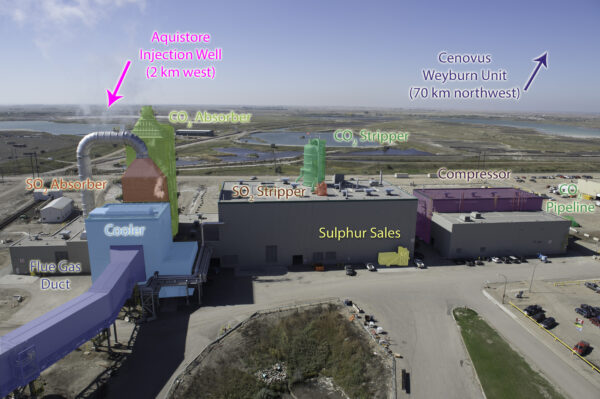Nine years after SaskPower pioneered carbon capture on coal, the US intends on adopting it wholesale. Now, if only the Canadian federal government would get behind it, especially when it comes to enhanced oil recovery.
You get carbon capture, and you get carbon capture …

When the SaskPower Boundary Dam 3 carbon capture project opened in 2014, nobody followed. The tech looked doomed as recently as a few months ago. On May 11, the US Environmental Protection Agency proposed that all coal and most natural gas power plants have carbon capture applied by 2038, or shut down.
Interestingly enough, last year, when I asked Crown Investments (and SaskPower) Minister Don Morgan if we would be doing any more carbon capture on coal, he said it was “not an option.” So, in Canada, it’s not an option, but in the US, it looks like it may soon be mandatory.
Coal to gas conversion?
Will Shand and/or Boundary Dam be converted from coal to gas-fired? No, but SaskPower is looking at it. If they do, that’ll be a whole lot of coal miners and coal processing staff out of work.
Guilbeault counters Moe, yet never says anything about keeping the lights on

Guilbeault calls Moe’s electricity grid statements “entirely baseless and untrue,” but never says anything about the planned policy of getting rid of all coal and natural gas power (86% of Saskatchewan’s power on some days this last winter.) Hmmmm….
Enough of this Net Zero by 2035 fantasy. Saskatchewan can’t do it
Moe draws the line in the dirt: “We will not attempt the impossible when it comes to power production”
The feds may want Net Zero by 2035, but Moe’s not having it
Net Zero by 2035? Not going to happen in Saskatchewan, according to Scott Moe. Natural gas, renewables, nuclear, and maybe even coal will be part of the mix. But Saskatoon is not going to freeze in the dark on Jan. 1, 2035.
(From Kate: SDA gets results.)
Breaking up with coal is hard to do

By federal regulation, one coal unit at Boundary Dam Power Station was supposed to shut down in 2021, another in 2024. Well, we’re not going to do that. Because we can’t. We still need them. Turns out all those wind turbines can’t be relied on, after all, can they? Like on April 4, when they put out less that 4% in Saskatchewan.
SaskPower may have no choice but to use SNC-Lavalin for SMRs
Ontario Power Generation recently signed up with the companies that are going to build its first small modular reactor. One of them is SNC-Lavalin.

And for those who don’t remember, SNC-Lavalin built the Boundary Dam 3 Carbon Capture Project. That didn’t work out as well as hoped. But we might not much choice in the matter.
Two days in a row, wind power was negative in Sask

The fog and calm winds have not gone away. Four days in a row, wind power in Saskatchewan was either negligible or negative. Two of those days were negative.
And remember that SaskPower is beefing up its interconnect to North Dakota and the Southwest Power Pool, from 150 to 650 megawatts? Well, as of 12:15 a.m., SPP’s power was 45% coal. So we will give up coal power here, and have option to buy coal power from the US. Because that’s what they rely on when the wind decides not to blow there, either.
Wind power production in Saskatchewan went into negative territory
Turns out there’s a new development out of the story that took place on Monday.
Justin Trudeau on Monday didn’t think much of Saskatchewan’s clean energy projects.
On that very day, characterized by fog throughout much of southern Saskatchewan (where the wind turbines are located), SaskPower’s total wind power generation fell to “-1 megawatt,” as in negative one megawatt, according to the Crown corporation’s Where Does Your Power Come From web page. This is the lowest number Pipeline Online has seen since the page went online in September, 2022. It’s also an average throughout the entire day, not just at a particular moment.
According to SaskPower, “The turbines were iced up and unable to produce. The -1 megawatt was load to service the facilities.”
Saskatchewan has 617 megawatts of installed grid-scale wind power generation.
Also, SaskPower is now paying people extra just to stay in Coronach instead of walking away early from the doomed coal plant.
What the minister has to say about the Sask First Act, and not freezing in the dark

Here’s a deep dive interview with the minister behind the Saskatchewan First Act.
“So let’s take let’s take the power thing first of all,” Eyre said, noting the proposed Clean Electricity Standard, if adopted in its current form, would mean no fossil fueled power generation in this province by 2035.
According to SaskPower’s Where Your Power Comes From website, on any given day, coal and natural gas combined provide 65 to 84 per cent of the power in Saskatchewan. On Nov. 6, it was 77 per cent.
Eyre said, “That’s a federal policy which we hope will never see the light of day, but which is moving along. We will freeze in the dark. And we know that. Saskatoon (is) powered by the Queen Elizabeth, a natural gas-powered power station. The entire City of Saskatoon (would be) in huge trouble.”
